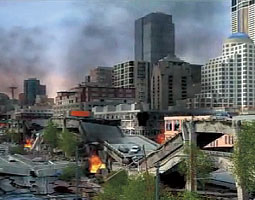An earthquake is like a big finger in a spider web. Touch one spot and parts of the web far away will move.
Dan Dolan has been pondering just how far away in the hopes that the web of our state’s vast institutional infrastructure doesn’t snap under the strain. Dolan, a professor of civil and environmental engineering, looked at how we might respond to and recover from damage to the state’s building and housing stock as part of the Resilient Washington State Initiative, a multifaceted assessment of the ways an earthquake can hurt us and how hard it will be to recover.

The quick answer: Recovery could be very hard, and picking up the pieces will involve a lot more than lifting bricks. Dolan found that major damage could pull health and safety personnel from distant corners of the state, while condemned homes could turn residents into refugees, as happened after Hurricane Katrina damaged the Gulf Coast. Areas sapped of people would then have a hard time recovering economically.
“We figure New Orleans has probably extended their economic recovery by at least five years because people left the community, and also the economy takes longer to come back,” says Dolan.
The state’s seismic underpinnings have nearly two dozen ways to do damage. The Cascadia subduction zone megathrust could pack a magnitude 9 “Big One,” while a catalog of earthquake scenarios compiled by the state Division of Emergency Management lists 19 other seismic faults and zones, most of which can produce a magnitude 7 or greater.
The last Cascadia event occurred in 1700, and the odds of another in the next 50 years are between 10 and 14 percent. A deep earthquake, like the magnitude 6.8 Nisqually quake of 2001, is a near certainty in the next half-century.
And the quake’s magnitude is only one measure of its destructive power. Even moderate shaking can wear structures into submission if it lasts long enough.
“The Chilean earthquake [of 2010] was two minutes long and the damage is significant,” says Dolan. “It doesn’t have to be as strong an earthquake. When you have it that long, fatigue takes over after a while. The damage accumulation gets to be too much. And we currently don’t design for earthquake duration. We only design for peak accelerations in our codes.”
Earlier this year, the Resilient Washington State subcommittee summarized assessments compiled by teams in four areas: critical services, utilities, transportation, and Dolan’s group, housing and economic development. The housing analysis showed some of the biggest shortcomings. To be resilient, single-family housing should be structurally sound, safe, and sanitary—fit for occupation—within a week of an earthquake. Housing group members were willing to let mid- and high-rise structures remain uninhabitable for a few weeks or months.
But the group found that houses built after 1950 might be uninhabitable up to a month and it could be three months to a year before older houses can be occupied. It could take up to three years before mid- and high-rise structures built before 1977 can be occupied.
One problem is many older apartment buildings have parking on the first floors with little support for the floors above. The 1994 Northridge earthquake near Los Angeles saw such buildings’ parking levels collapse or “pancake.”
“If you look around Aurora or drive up and down I-5, you’ll see a lot of those buildings where a first floor is parking and then two to three floors of apartments above it,” say Dolan. “And all are on steel columns, steel-piped columns or something like that. There’s no lateral capacity on that first floor. And we perceive that as being a really large risk to having a resilient community because if those buildings come down, they’re no longer habitable.”
Similarly, if buildings were to fail at, say, the University of Washington, students might need to attend classes somewhere else. Which is where the spider-web analogy comes in: Damage on the west side of the state could force residents on the east side to make do with fewer doctors and less police protection, and WSU might have to temporarily teach UW students.
“We think that there will be significant damage,” says Dolan, “at which point our schools will become crowded. If UW gets really hammered in some of their older buildings, well what are those students going to do? Are they going to just stop them, not let them continue? We’re going to have to support them. That’s part of being part of the state.”
That will indeed be a topsy-turvy moment, when Huskies become Cougars.
Web extra
The dangers of a major Cascadia earthquake
On the web
Washington Emergency Management Division: Seismic Safety Committee
Evacuation towers may be the only hope (The New York Times)
